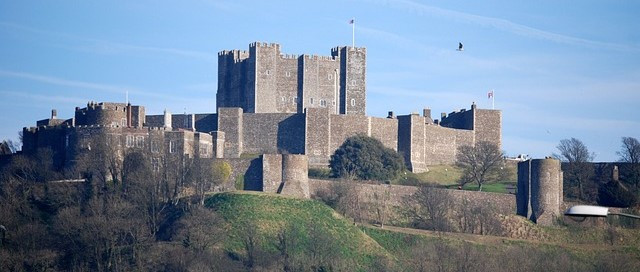Motte and Bailey Castles
This section explains the building of Motte and Bailey Castles. After the Norman Conquest of England in 1066, the Normans introduced a new style of fortification that was very different from the Anglo-Saxon burhs. Norman castles, particularly the motte and bailey type, were not primarily defensive structures in the same sense as the Anglo-Saxon fortifications; instead, they served as symbols of Norman dominance and were intended to instil fear in the Anglo-Saxon population. These castles were designed to remind the conquered people of Norman power and control over the land.
Design and Purpose of Motte and Bailey Castles
The motte and bailey castle consisted of two key components: the motte, a large earth mound, and the bailey, a flat area typically enclosed by a wooden fence or palisade. The motte was often topped with a wooden tower known as the keep, which served as the residence for the castle's lord and a final stronghold in times of attack. The bailey was where the daily life of the castle took place, with barracks for soldiers, workshops, and storage areas. This design made it easier for the Norman settlers to defend their new territory and maintain control over their newly acquired lands.
Norman castles were often built in locations with strategic importance, such as on hilltops or near major roads, rivers, or towns. This ensured that the castles not only served as military strongholds but also as administrative centres. The presence of these castles across the landscape was a clear visual reminder to the Anglo-Saxon population of the change in power and the dominance of the Normans.
Speed of Construction
One of the key advantages of the motte and bailey castle was its ability to be constructed rapidly. Unlike the more elaborate and permanent fortifications of the Anglo-Saxon burhs, which required significant planning and time to build, a motte and bailey castle could be erected in a matter of days or weeks. This speed was vital for William the Conqueror, who had approximately 8,000 men to secure his rule across England.
In the immediate aftermath of the Norman invasion, these castles were built quickly to help secure towns that had submitted to Norman rule or to intimidate those that had resisted. The speed of construction meant that Norman forces could consolidate their control over large areas of land in a short period of time. The castles provided a base from which soldiers could launch attacks, gather supplies, and exert control over the local population.
Temporary Wooden Structure
While effective in the short term, the motte and bailey castle had a significant weakness: the wooden construction. The wooden keep was vulnerable to decay, fire, and attack. In a climate that often experienced wet conditions, the wood could rot, and if set on fire, the keep could be destroyed. This meant that although motte and bailey castles were quick to build, they were not as durable as stone castles, which were more resistant to the elements and fire.
However, the motte and bailey design was intended as a temporary solution. The Normans often used these castles as a stepping stone before constructing more permanent stone fortifications. Once the Normans had established more control and had the time and resources to build, many motte and bailey castles were replaced by stronger stone keeps. The stone keep provided greater security and durability, although this came with the challenge of the weight of the stone potentially causing the motte to sink into the ground. As a result, stone keeps were not always built directly on top of the original motte, and sometimes a new mound would need to be created for the stone structure.
Examples of Motte and Bailey Castles
- Pevensey Castle: The first Norman castle built in England after William's landing in 1066 was at Pevensey, located near the site of his landing at Senlac Hill. The castle was quickly constructed in the motte and bailey style and became a key base for William's forces in the south of England. Its location near the coast was strategic for controlling access to the rest of the country.
- York Castle: Another example of a motte and bailey castle is the one built in York, following the Norman conquest of the city. The Normans quickly constructed a motte, which still exists today as a prominent feature of the city. Over time, a stone keep replaced the wooden structure, making York Castle one of the most famous examples of the evolution of Norman fortifications.
- Dover Castle: Dover Castle was an important Norman stronghold located at a key point of entry into England. The original motte and bailey castle was built after the Conquest, with a wooden keep on the motte. This was later replaced by a stone keep, as the castle's importance grew (see the below picture which shows Dover Castle as it currently looks).

Conclusion
Motte and bailey castles played a crucial role in the consolidation of Norman rule over England. Their ability to be quickly built made them effective tools for securing land and intimidating the Anglo-Saxon population. Although they were vulnerable to fire and decay due to their wooden structure, the Normans used them as a temporary solution until more permanent stone castles could be constructed. Over time, these castles evolved into the grand stone fortresses we associate with the Middle Ages, marking the long-lasting impact of the Norman Conquest on England’s landscape and architecture.
